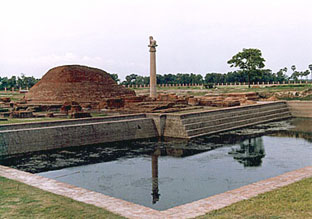Vaisali, World's First Republic
Source: http://wiki.answers.com/Q/What_was_the_first_republic_in_the_world
http://stubbs.hubpages.com/hub/Interesting-Facts-2

One of the earliest instances of a civilization with a democracy was that founded in the republics of ancient India, which were established roughly somethime before the 6th century BC. These republics were known as Maha Janapadas, and among these states was Vaishali (in what is now Bihar) would be the world's first ever republic. It is interesting to note that The Republic of India is currently the largest democracy in the world, and so argueably also the oldest.
Rome and Greece had republics much later, but as usual, the perception among people is that first republic or democracy came from Europe, which is wrong.
It is worth noting here that Vaishali was known for its successful grassroots democracy that helped it reach the zenith of its greatness. The Panchayats perforce, kept on doing a lot for the welfare and development of the villages and regions. The work also delineates as to how the Government at Vaishali functioned and what its exact nature and form were. The 'Executive council' apparently was the working government of the polity. But the fact remains that whatever it did, it did in accordance with the wishes of the 'gana' (assembly) that had always been responsible for rendering justice to all the people, regardless of their religion, race, caste, sex or place of birth. The government was fully authorized by the constitution to act freely and independently, provided it remained accountable to the assembly, the repository of sovereign power.
It was here in 599 BCE the 24th Jain Tirthankara, Bhagwan Mahavira was born and brought up in Kundalagrama in Vaishali republic, which make pious & auspicious pilgrimage to Jainist. Also Gautama Buddha preached his last sermon before his death in ca 483 BCE, then in 383 BCE the Second Buddhist council was convened here by King Kalasoka, making it an important place in both Jain & Buddhists.
At the time of the Buddha, Vaishali, which he visited on many occasions, was a very large city, rich and prosperous, crowded with people and with abundant food. There were 7,707 pleasure grounds and an equal number of lotus ponds. Its courtesan, Amrapali, was famous for her beauty. The city had three walls, each one gávuta away from the other, and at three places in the walls were gates with watch towers. Outside the town, leading uninterruptedly up to the Himalaya, was the Mahavana, a large, natural forest. Nearby were other forests, such as Gosingalasála.
The city finds mention in the travel accounts of Chinese explorers, Fa Hian (4th century CE) and Xuanzang (Hiuen Tsang) (7th century CE), which were later used in 1861 by British archaeologist Alexander Cunningham to first identify Vaishali with the present village of Basrah in Vaishali District, Bihar.
Vaishali derives its name from King Vishal of the Mahabharata age. The city was also called Visálá Buddhaghosa, the a 5th-century Indian Theravadin Buddhist commentator and scholar says, that Vesali was so called because it was extensive or Vishal.